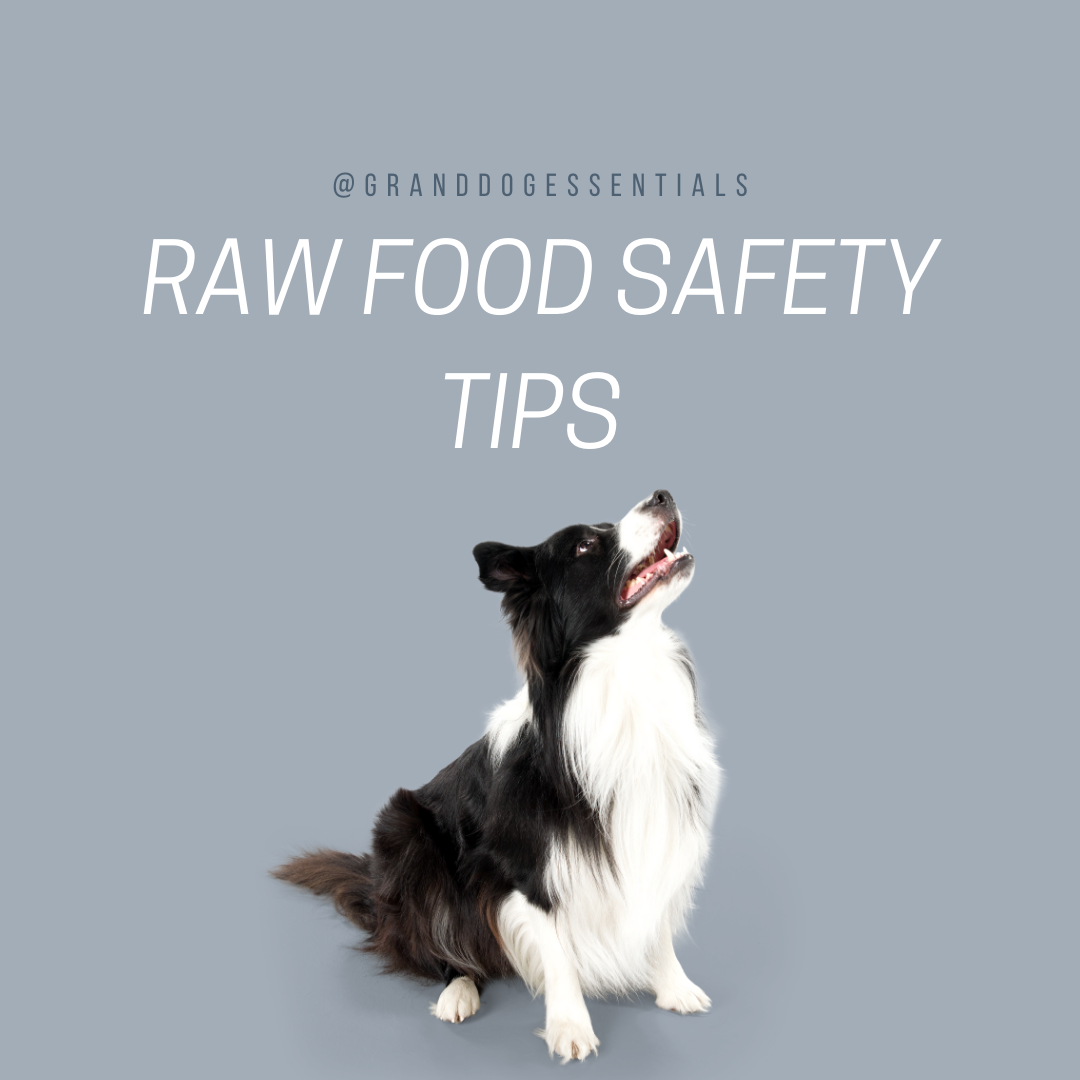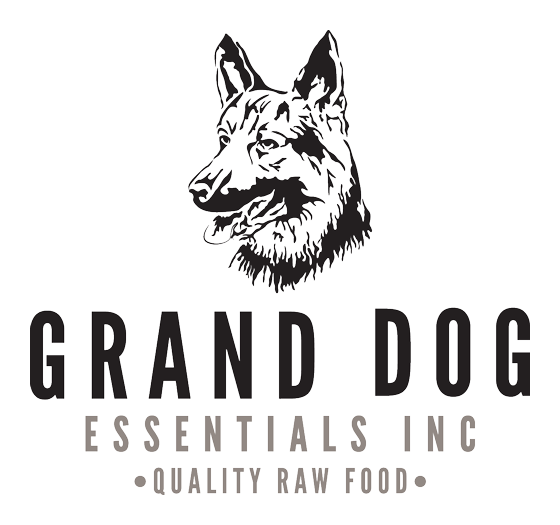Raw Dog Food Safety 101: 7 Tips to Keep You and Your Dog Safe
December 9, 2020 – Amanda Monsma

A common misconception people have in regards to raw feeding is that it is unsafe and carries a higher risk of food borne illness from bacteria for dogs and people. Handling raw meat and vegetables (yes, even vegetables!) will always come with a risk whether it's for our dinner or for our pups. We aim to share with you seven tips that will help in preventing food borne illness and keep you and your dog safe while feeding raw.
1. Wash your hands!
We begin with the most obvious and the theme of 2020. One of the most effective ways you can prevent illness due to bacteria is washing your hands regularly.
Wash your hands after:
- You serve their food
- Feed treats
- Handle their empty bowls
- Remove food from wrapping
- After you pick up their poop or old bones
- After they lick you (especially if they have just eaten)
Below is an outline on proper hand washing technique from the Government of Canada website.
1. Remove jewellery such as rings
2. Wet hands up to the wrists
3. Apply enough soap to cover hands
3. Work soap under fingernails and around and between joints and fingers for a minimum of 20 seconds
4. Rinse off all lather with water
5. Dry hands with a clean cloth or paper towel - take special care to dry thoroughly between fingers
6. Turn off the tap with a paper towel or cloth
2. Designate utensils and air tight container to be used only for the raw dog food.
Keep these items separate from the other kitchen items you use on a regular basis, even when clean. This will prevent others from accidentally using them for human consumption purposes.
Make sure other family members in your house know what is designated for raw dog food. You could even go as far as labelling the items so there is no confusion and for people who may look after your dog(s).
Wash these items seperate from your other dishes. I like to leave them to the very end or I will add to the dishwasher and run the sanitize option.
Replace utensils and containers when they start to show signs of wear and tear, especially if using plastic containers or untesils. Some signs to replace your tools: lid doesn't fit properly, surface is no longer smooth and has scratches or indents in it, you're using something plastic that is over 10 years old.
3. Feed your dog pre & probiotics.
Dogs have evolved to eat raw meat and handle the bacteria that comes with it. When you feed a whole food diet that is biologically appropriate, your dog's body is able to function the way it's meant to.
With a raw diet, you are ensuring that their stomach and intestinal tract has lower PH levels- making the stomach environment more acidic - which allows them to properly break down the food and bone they eat. High acid levels also slows the growth of bad bacteria in their body.
Feeding kibble can deplete your dogs ability to fight against harmful bacteria by raising the PH levels in your dogs stomach making it less acidic. The less acidic their stomach, the higher the risk bacteria like Salmonella can survive and cause upset in your dog. This is why I recommend Apple Cider Vinegar when you are transitioning from kibble to raw - the ACV helps bring your dog's PH levels down and in turn helps them properly digest and absorb nutrients from their food.
Another way to amp up your dogs bacteria fighting power? Feed pre & probiotics. This is especially important if your dog is new to raw, on antibiotics, or if you are feeding a mix of kibble and raw together. Building up your dogs good bacteria (probiotics) helps push out the bad bacteria and allows their immune system to function properly. With a properly functioning immune system, they are better able to fight off any bad bacteria that may make it through their digestive process.
Prebiotics is food for your probiotics. When you feed probiotics, you want to ensure you are also including prebiotics in their diet to help the good bacteria grow and flourish. Find probiotics in our store here.
4. Before feeding or unwrapping a new tube of food, make sure to clear your surface removing any human food or dishes to prevent cross contamination.
You never know when you might have a piece of food go rogue and you lose track of where it went. Try to keep note of any small pieces and clean them up immediately.
After feeding, wash all surfaces, utensils used, and dishes. The utensils and dishes can go into your dishwasher if you are running it that night - I would suggest using the sanitize cycle when you do. Otherwise, clean the dishes using hot soapy water.
Wipe down your surfaces first with a cloth using hot soapy water followed by a disinfectant wipe down. Disinfectants loose their efficacy when it comes into contact with items like food or dirt which is why it's important to wipe down the surface before the disinfectant wipe down.
Natural anti-bacterial products include distilled white vinegar, fresh lemon juice, or hydrogen peroxide. There is a wide array of recipes online if you do a search or you can stick to Lysol wipes. One DIY disinfectant spray recipe I recommend is from Wellness Mama.
5. Feeding the dogs should be an adult job only.
Until they are old enough to understand and follow proper feeding and cleaning protocol, children should be on the sidelines for feedings. For my little, I ask her to watch from a distance when I am feeding the dogs. My dogs get so excited around dinner time, it's best not to have too many bodies around.
As soon as your dog(s) are done eating, remove the dish, clean, and store where they are out of reach from the children. Discourage children from playing with the water dish. Setting those boundaries from the very beginning limits possible contamination and provides safe spaces for your dogs when littles are around so they don't feel the need to protect what they feel is theirs.
Observe the same safety tips as you would when preparing raw meat for your own dinner. Clean the area, wash your hands.
I personally don't allow dogs to lick us at any time but especially after feeding. If your dog has a long beard you want to take and extra step of precaution, you could give them a good wipe after eating. I've personally don't wipe the dogs and have not had any issues, but it's another safety measure you could consider.
6. As soon as you are able to after your box of Doggy Moggy is delivered, put the food in the freezer until ready to use.
According to the Government of Canada website, temperatures between 4 °C (40 °F) to 60 °C (140 °F) are considered a "danger zone" where bacteria can grow quickly. The ideal temperatures are 4 °C (40 °F) or lower for the fridge and your freezer at -18 °C (0 °F) or lower.
Keep the dog food separate from other items in your freezer or fridge. If you are able to keep the food in the original box, do so. If not, use bags to provide separation from other food items.
Thawing the dog food completely in the fridge is the ideal method to ensure the highest level of safety. Since dogs are better able handle higher bacteria loads than humans, leaving the dog food on the counter to kickstart the process is acceptable. I suggest thawing on the counter until it is partially thawed, then move to the fridge. We don't recommend leaving out overnight or for long periods of time. Bacteria thrives at room temperature.
Raw dog food that has been thawed in the fridge should be consumed by your dogs within 3-5 days. If it's been thawed on the counter for a period time, the food should be fed within 2-3 days. Raw dog food can be stored for 6 - 12 months in the freezer. Ideally the food would be consumed within 6 months to ensure quality is maintained.
7. Wash all produce before serving and DO NOT wash raw meat.

6 comments
Hi Hope! I agree that bones should be given in a crate or outside. Somewhere that is easy to clean (definitely not on carpet).
When i occaisonally give my dog a raw neck bone i always feel like I need to crate her because of germs and she gets it on her fur too!
Hi Stephanie! Yes, if your dog doesn’t finish their food, put it back in their container and store in the fridge. Take out later in the day to feed or save for the next day. Some dogs like to graze and have smaller meals during the day. That’s ok. Follow their lead and create a schedule that works for both of you.
Hi there, thanks for all the info above, it’s very helpful! I am wondering please, if my dog doesn’t finish his raw meal, can I put it into a tight container and give it to him later that day, or the next morning? Sometimes he’s fussy and doesn’t finish it all.
Thank you!
I’m so glad it’s resonating with you! Raw is always best, but you could consider serving at room temp or with a little hot water and see if that helps!
Hi Amanda
Just checking out all you do and think it’s great. Curious mynpup has a harder time with raw so I have been doing homemade that is low temp gently cooked. Can you lightly cook your premade or do you not suggest that?
Thanks